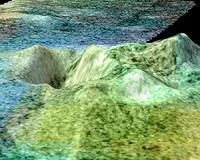 |
for Astrobiology Magazine Moffett Field CA (SPX) May 06, 2011 Oddities in the rotation of Saturn's largest moon Titan might add to growing evidence that it harbors an underground ocean, researchers suggest. Titan, which is larger than Mercury, is the only world besides Earth known to have liquid on its surface. Its seas, made of liquid methane instead of water, have often led to speculation as to whether or not they could host life. In addition to its seas on its surface, scientists recently also discovered hints that Titan possesses an internal ocean, one of water and ammonia. Using radar to peer through Titan's dense atmosphere, NASA's Cassini spacecraft found that over time, a number of prominent surface features had shifted from their expected positions by up to 19 miles (30 kilometers), showing that the crust was moving and suggesting that it rested on liquid. Now Cassini's gravity and radar observations of Titan have discovered more clues that it might have an underground sea. Titan apparently has an orbit very similar to our moon's - for instance, it always presents the same face toward its planet. However, they noted that Titan's axis of rotation was tilted by about 0.3 degrees. This tilt, or obliquity, seems high, given the estimate of Titan's moment of inertia, or its resistance to changes to its rotation. One implausible reason for these findings is that Titan is a solid body that is denser near the surface than at its center. "This is in contradiction with all we know about others planets and satellites and planetary formation processes," said researcher Rose-Marie Baland, a planetary scientist at the Royal Observatory of Belgium in Brussels. Another more likely explanation is that Titan is not solid all the way through, but has an icy shell overlying a liquid water ocean, an icy mantle and an icy, rocky core. The research team's models can give a wide range of thicknesses for the liquid ocean, anywhere from three to 265 miles (five to 425 km), as well as for the icy shell, anywhere from 90 to 125 miles (150 to 200 km). "We found it very exciting to use some measurements that seem in contradiction and to try to reconcile them," Baland said. "It was like putting together pieces of a puzzle." Still, the case for Titan having an underground ocean is not closed yet. Its orbit and rotation might also be explained by a recent disturbance, such as a collision with a comet or asteroid. "Our analysis strengthens the possibility that Titan has a subsurface ocean, but it does not prove it undoubtedly," Baland told Astrobiology Magazine. "So there is still work to do." Since life as we know it needs liquid water, if Titan does have a subsurface water ocean that may increase the chances the moon could harbor alien life. In the future, Baland noted that she and her colleagues would like to use this method to analyze Jupiter's four largest satellites, the Galilean moons - Io, Europa, Ganymede and Callisto. "The measurement of the obliquity of Europe or Ganymede could bring additional evidence for subsurface liquid layers," Baland said. Baland and her colleagues will detail their findings in a forthcoming issue of the journal Astronomy and Astrophysics.
Share This Article With Planet Earth
Related Links Cassini Explore The Ring World of Saturn and her moons Jupiter and its Moons The million outer planets of a star called Sol News Flash at Mercury
 Titan Shaped By Weather Not Ice Volcanoes
Titan Shaped By Weather Not Ice VolcanoesPasadena CA (JPL) Apr 11, 2011 Have the surface and belly of Saturn's smog-shrouded moon, Titan, recently simmered like a chilly, bubbling cauldron with ice volcanoes, or has this distant moon gone cold? In a newly published analysis, a pair of NASA scientists analyzing data collected by the Cassini spacecraft suggest Titan may be much less geologically active than some scientists have thought. In the paper, published i ... read more |
|
| The content herein, unless otherwise known to be public domain, are Copyright 1995-2010 - SpaceDaily. AFP and UPI Wire Stories are copyright Agence France-Presse and United Press International. ESA Portal Reports are copyright European Space Agency. All NASA sourced material is public domain. Additional copyrights may apply in whole or part to other bona fide parties. Advertising does not imply endorsement,agreement or approval of any opinions, statements or information provided by SpaceDaily on any Web page published or hosted by SpaceDaily. Privacy Statement |